Wetlands through Megan's Lens
About Megan
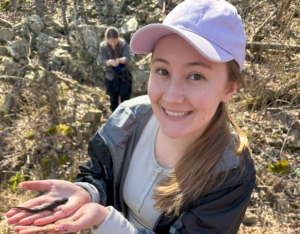
My name is Megan Scholl, and I am a senior at Drury University, a small college in Springfield, Missouri. As a Missouri native, I have lived a rural life, where I have seen deer, turkeys, turtles, and fish all cross my backyard. I have witnessed the migration of geese and the hibernation of salamanders. I know about life cycles, weather conditions, and seasons. These are all things that people witness in the Midwest across time and seasons. As I’ve grown up, I have come to see that our climate is changing, and I must address its many implications.
Fast forward to my final year of college, and I have two majors, including Elementary Education and Biology, and an additional certificate in Designing Solutions for Environmental Problems. As I prepare to become an educator, I am more aware of how climate change impacts our environment. Since January, I have been working on a capstone project on wetlands in Missouri. I have always been passionate about sustainability, so I was excited to start working on this project. Before I began researching, I did not know how important wetlands really are and how endangered they are. Pollution and global warming are at the forefront of people’s minds when they think of environmental sustainability. However, I chose to focus on wetlands because they do not get the attention they deserve as an integral part of our planet’s ecosystem. Wetlands are important, but we do not see them every day or hear about them in the media. In order to bring awareness to the destruction of wetlands, I collaborated with the Watershed to research the importance of wetlands and create an infographic. This post shares some of my findings and relates a recent experience I had with the Arkansas wetlands.
Wetlands
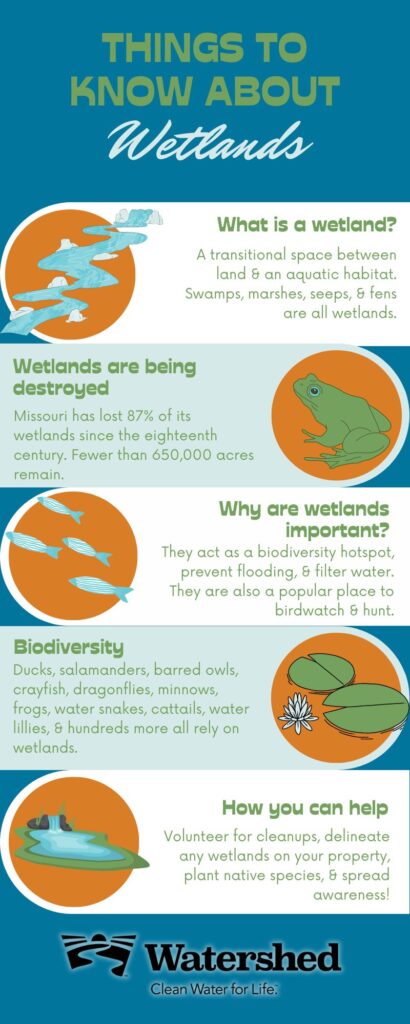
Swamps, marshes, wet meadows, fens, and seeps are all different kinds of wetlands in the state of Missouri. Wetlands are transitional spaces between land and aquatic habitats. They are one of the world’s most important ecosystems because they have immense biodiversity, provide fresh water, and prevent flooding. By providing habitat to hundreds of species, wetlands serve as a biodiversity hotspot. Fish use wetlands for mating, frogs lay their eggs, migratory birds stop and rest, and they are the primary habitat for over 200 species of conservation concern in Missouri. Being of conservation concern means they are listed as rare, endangered, or unknown. Without wetlands, there would be a huge loss in biodiversity because so many plant and animal species would lose their home. In addition to providing habitat to various species, wetlands provide several uses to humans. Wetlands are the number one source of freshwater in the world, which is important to note because less than 1% of the water on the planet is available for direct human use. Wetlands actually filter water by removing pollutants and sediment, which makes the water safe for human use. Furthermore, wetlands help to prevent flooding by holding onto water. The excess water is slowly released back into the groundwater table. Wetlands provide many benefits to the ecosystem and to humans directly.
Unfortunately, 87% of the wetlands in Missouri have been lost. Prior to European settlement in the eighteenth century, there were about 6 million acres of wetlands, and today there are fewer than 650,000 acres. The main source of this loss is agricultural development. Farmers develop their farms directly on top of wetlands because the soil is very fertile and full of nutrients; they also provide clean water, which are ideal conditions for crops to thrive. Because the wetlands are turned to farmland, the species living there have no where to go and become isolated. The drinking water can no longer be filtered by the plants in the wetlands and is instead polluted with farm runoff. Wetlands are a beautiful resource that will continue to deplete in number if nothing is done to preserve them, which will harm biodiversity and human wellbeing.
Arkansas
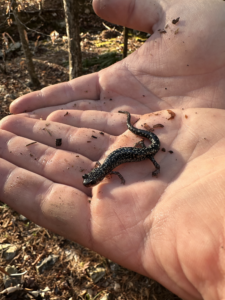
As I was conducting this research, the perfect opportunity presented itself. My herpetology class planned a trip to Arkansas to find and catch all kinds of salamanders, frogs, and snakes, which can all be found in wetlands. The trip was to the Ouachita Mountains in Mena, Arkansas, from March 9th through the 11th. My class stayed at the Ouachita Mountains Biological Station. On our first night there, we explored the area close to the station and found southern Red-backed Salamanders, Many-ribbed Salamanders, Ouachita Dusky Salamanders, Green Frogs, and one Southern Coal Skink.
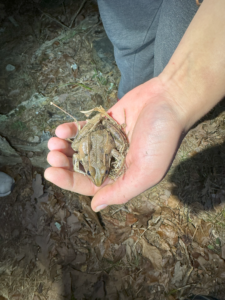
The second day was spent visiting the Fourche, Rich, and Caddo Mountains. Each of these mountains has its own endemic species of salamander. We visited many ponds, creeks, seeps, and roadside swales because these are common homes for salamanders. We spent the entire day flipping over rocks, searching under fallen trees, and digging through leaves in the water. We were able to find all of the species previously mentioned: the Caddo Mountain Salamander, the Rich Mountain Salamander, and a Flat-headed Snake! We also saw a few water snakes but were unable to catch them. Unfortunately, we were unable to find a Fourche Mountain Salamander.
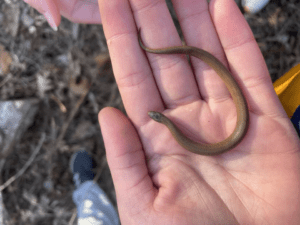
On the final day of the trip, we did not search for any more herps and drove home. I really enjoyed the trip, and it is something I would love to do again. My favorite part was interacting with all the species I have been seeing in my wetlands research. Seeing all of the animals and plants that rely on wetlands up close for survival has encouraged me to become an advocate for them. They cannot protect wetlands themselves, so we have to do it for them. One big way to preserve wetlands is to have them delineated if they are on your property. By doing so, clear boundaries are created that prevent their accidental destruction or pollution. You can also plant species that are native to Missouri. Doing so supports pollinators, promotes biodiversity, and provides food and shelter to wildlife. One more way to help wetland preservation is by spreading awareness. Most people simply do not know that the destruction of wetlands is a problem. If enough people show that they care about this issue, we can make a change! I hope that after reading this, you have a new understanding of wetlands and are willing to help save them.

